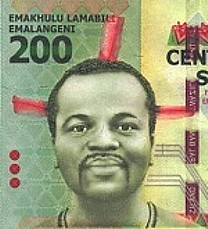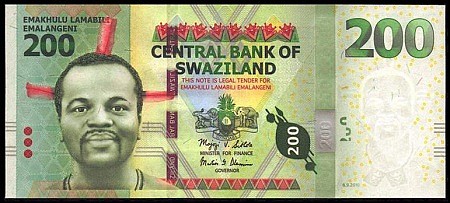SWAZILAND - ESWATINI
King Mswati III

Traveling from Mozambique around 1750, the Swazi people migrated into Zululand, and were slowly pushed north into the area of modern Swaziland. Under the rule of Mswati II they were able to expand north as well as repel continued Zulu attacks from the south. This came at a price, however, as Mswati II agreed to let the British assist him in fighting the Zulus. As a result, the British administered the area and white immigrants settled in the area, who claimed land and resources.
Born in 1899, Sobhuza II ascended the throne slowly after the death of his father, Ngwane V. According to custom, when a king dies, the royal family assembles to decide which of his wives will be granted the title of “Great Wife”. Once this is done, the eldest son of the Great Wife is destined to become king. This son is then a Crown Prince, and is not crowned King until the late king’s wives have all mourned his death for two years. That was not much of a factor for Sobhuza II, as he was not even a year old at the time. This being the case, his grandmother was installed as regent until December 22, 1921, shortly after he turned 21 years old.
Still under British administration at this time, Sobhuza II actually became a Paramount Chief, a title used to designate the highest regional chief of a tribe. The British would not allow a leader of one of the possessions to have a title of King or Queen, as they thought that would undermine their authority. The British expected that Swaziland would eventually be absorbed by South Africa. But as time went on, South Africa’s discrimination against blacks increased with their apartheid movement, and the British continued their administration rather than subject the Swazi’s to the injustices and humiliation of apartheid. Throughout the 1960’s Swaziland saw the emergence of new political parties, many of which were formed to advocate independence. These new political voices were heard and on September 6, 1968 Swaziland was granted independence.
Ngwenyama Sobhuza II was titled King on Swaziland’s independence, and became the absolute ruler. In 1973, Sobhuza II repealed the constitution which was based on tribal governments, yet continued the tribal practice of having multiple wives, in his case 70 of them. By tradition, a king must have his first two wives appointed by councilors. These two wives must be from the Matsebula tribe and the Motsa tribe and they serve special roles in ritual practices. Furthermore, their children are not allowed to ascend to the throne. The king is then allowed to take other brides as he deems fit, though by tradition, they must prove their ability to provide an heir by becoming pregnant before they can be married. One occasion in which the king usually takes a wife is during the Umhlanga (Reed) Dance. This is a ceremony in which maidens pay tribute to the Queen Mother by presenting her with long reeds that are made into a windbreak for her house.
When he died in 1982, Sobhuza, through his 70 wives, had fathered over 210 children (though only 180 survived) and over 1000 grandchildren. His wife Ntombi succeeded in being the “Great Wife” and thus became regent to her son Mswati III, who became Crown Prince in September 1986 at the age of 18.
Mswati III, was born under the name of Makosetive Dlamini on April 19, 1968. In addition to attending school in Swaziland, he also attended the Sherborne School in England, a private school dating back to the eighth century. He also joined the Swaziland military force USDF (Umbutfo Swaziland Defence Force) which is used to quell domestic protests as well as having some border duties. Mswati III was crowned King on April 25, 1986, and was at that time the youngest reigning monarch. In 2004, Mswati III declared a new constitution which allows greater freedom of speech.
One of Mswati III’s controversial actions was when he attempted to help an outbreak of HIV in 2001. He declared that the traditional chastity rite, known as the Umchwasho, was in effect. According to tradition, the Umchwasho lasts for five years, and forbids unmarried girls from having sex. Girls under 18 are required to wear blue and yellow wool tassels around the neck. Girls who are 19 are to wear red and black tassels and are allowed limited physical contact with males. Mswati III was criticized when he took a bride who was only 17 years of age at the time. He fined himself the traditional one cow for violating the rite. Despite this and other efforts, Swaziland maintains the highest rate of HIV in the world with a declining life expectancy.
Mswati III has been criticized for grand living, and, according to the newspaper ‘The Independent’ of Zimbabwe, the royal family has been accused of impeding economic activity through its control of local companies. A 2009 recession in South Africa largely affected Swaziland as well. Further criticism was launched when the King refused to reduce spending on both the USDF and the royal household. Recently, though the country has a current life expectancy of only 32 years, the king celebrated his 40th birthday in opulent style, which drew further even more criticism and protests.
Swaziland is Africa’s last Absolute Monarchy. Its ability to last as one is constantly being challenged by repeated actions of Mswati III during the economic hardships that the country suffers through while the royal family continues its unfettered extravagance. Mswati III’s portrait adorns each denomination of Swaziland’s banknotes. He is seen here on the 200 Emalangeni banknote issued in 2010. King Mswati III renamed the country from Swaziland to Eswatini in April 2018.

